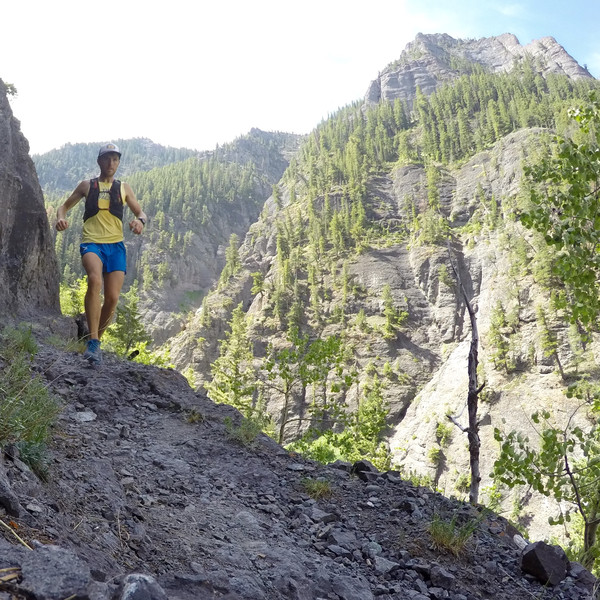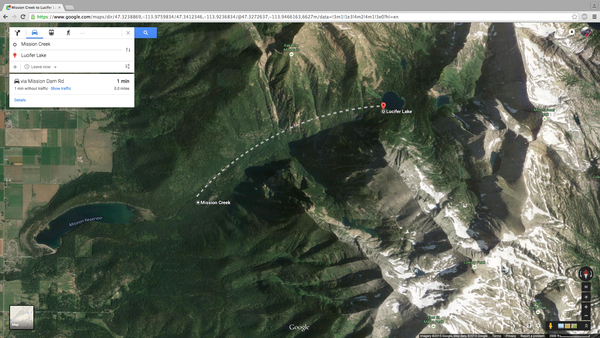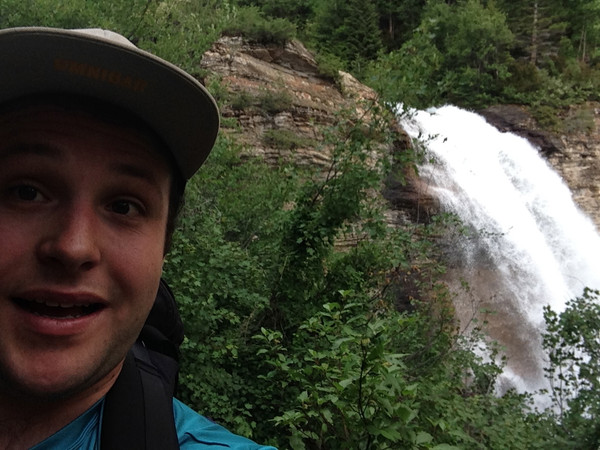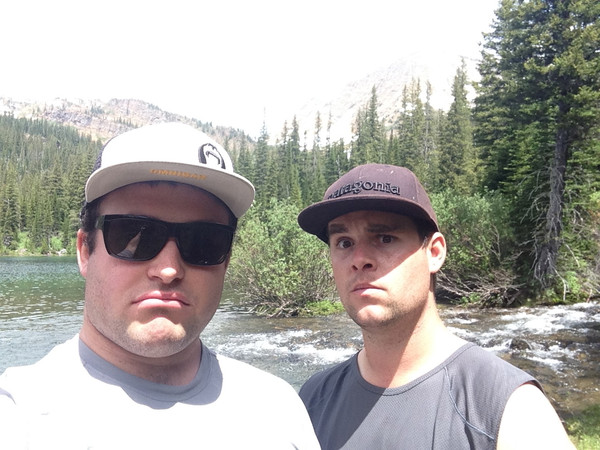- Continue Shopping
- Your Cart is Empty
Endurance Driven Ingredients
We all know food is medicine. But what is the best food for marathons or preparing for an endurance-driven event? Omnibar set out to help answer that question using ingredients found in their products. View full article →Hardrock 100 - Mike Foote Q&A;
Mike Foote has been training hard for the Hardrock 100, which is coming up this weekend, so we asked him to have his fans submit questions via his Instagram and Facebook about what it takes to train for the race. There were a lot of questions so we chose some of our favorites. Some are on topic and others not, but here are Mike’s answers.
If you don’t see your question answered below please reach out to us on our Facebook page and we’ll do our best to get it answered.
- -
Foote on course getting some final training in last week.
It was a fun process to answer these. Thinking back on my preparation leading into the race is a good exercise. Thanks again for all the questions. Here’s my best crack at answering them.
@ mdsears - With great success in running Hardrock in 2010, what was your greatest lesson on the course you can use to hopefully improve your experience?
Great question. I’ve thought about this quite a bit actually. I literally came into this race blind in 2010, with no real knowledge of the course, or expectations. Without much knowledge of the course I didn’t really have a true respect for it. After completing it in 2010, I now know how burly this race is and have prepared better and more specific for it than in 2010. Also, I believe in the “go slow to go fast” principal, which is to say that I learned that by moving well, but without rushing, will lead me to my best performance on a course like this.
@dumpster_diver - What metrics did you change in your training compared to other 100’s? Time? Distance? Vert?
With a little nudging from my coach, Jason Koop, I really honed in on the specificity principal this year. In years past I would run a 120-130 mile week with 18-20,000 ft of vertical gain on the much more runnable trails in Missoula to prep for a race like Hardrock or UTMB, which are both much steeper. Hardrock, for example, is 100 Miles with 33,000 ft of gain. Therefore, even though the amount of time I was running in my final training block was similar this year to years past, I ran less overall mileage at a slower pace on steeper terrain to mimic the Hardrock race pace.
Also, my higher mileage weeks (100+) were lower in number than years past. I did lower volume, higher intensity training blocks leading into my higher mileage training block which has only been the last 8 weeks or so. I hope that leaves me from feeling too overcooked on the starting line, which I have been guilty of in the past.
@ k__pat - How do you keep a smile on your face when the mountains can be so brutal Foote?! It's very inspiring!
I was blessed with a grimace that somehow looks slightly like a smile. It is very deceiving.
@mhiday82 - What are some of your favorite nutritional sources for fats and proteins while running?
This may not come as a surprise, but Omnibar fills that niche quite well for me. They are a great balance of carbs, fat and protein and are made with real food ingredients, such as sweet potatoes, almond butter, oats and flaxseed meal, which are a big part of my diet anyways. Also, they are a great break from the more sugary fuels I take in during a race like Hardrock.
@young_cappy - Did you see yourself running such a prestigious race in the early stages of your running career? Also what do you feel now looking back on your beginnings as an ultra runner?
Good question. I very clearly remember a good friend and early mentor for me in ultra running telling me to sign up for Hardrock in 2010. I don’t think I had ever heard of it before. Never the less, I took his suggestion, signed up for the lottery, and was fortunate enough to get in. So I didn’t see it as prestigious because I literally didn’t know any better. Looking back at it all now, there was a freshness and simplicity to it all that was intoxicating. My relationship with running has changed a lot in the last 5 yrs since my first Hardrock, for better and for worse at times. In the end, its races like this, and the culture that surrounds it that reminds me why I fell in love with this sport in the first place.
@gsleblanc - What's it like to see the sun rise, set, then rise again before you cross this race's finish?
For me, the first sunrise goes slightly without notice as it usually coincides with the beginning of the race and there is a lot for other stimulus that drowns it out a bit early on. The sunset though is fairly ominous. And the second sunrise is so glorious and warming and life giving, it is hard to put into words. My energy and spirit are at their lowest during the hours just before the second sunrise and it really re energizes me for the final push.
@fojovo - What do you do to prevent overuse injuries while training for a 100 miler?
Knowing myself well enough to integrate proper rest when I’m close to the limit of going over the edge into an injury. I also do active release stretching, foam rolling and massage. And finally I really believe in strength training, if done properly, to strengthen your core and keep your form efficient so that you are less likely to open yourself up to injuries. I employ all of these strategies to try and stay injury free. In my experience in the last 6 years of competitive running, the more I integrate all of these things into my routine, the healthier I am. Funny how that works.
@natefsmith - What do your cross train days look like? (i.e. any gym time, upper body, swimming etc)
In the winter I do a lot of ski mountaineering training and back country skiing. I find it to be such a good way to give my body a break from all the pounding of the running season. Once I am in the running season though my cross training is pretty limited. In an ideal world, and when I’m in a good groove, I do a 15-20 minute core/strength training workout 2-3 times a week to make sure I’m keeping muscles firing and balanced. I make it a point not to get too crazy in the gym though with anything that trashes me too bad, since I do enough of that from running, but I do just enough to keep feeling healthy and strong to compliment the running.

Foote on course training
@jeremywolfrun - How hard was it for you to come to terms with training and racing using hiking poles?
After a winter of using them in my ski mountaineering training I figured I would keep the party going. Plus, I just had to sincerely ask myself if I thought using poles would get me to the finish line of the race faster, and I think they will if used appropriately.
@jaxcharlie - How much time have you spent above 10K feet?
@fboughner13 - How do you prep for the altitude of such a high race while doing most of your training much lower?
Its tough to be fully prepared for the high country of Colorado while living in Western Montana. Missoula sits at 3,200ft, which is a far cry from the 11,000ft average elevation of the Hardrock Course. This year, I partnered up with Hypoxico Altitude Training Systems and got myself an altitude tent for the last 4-6 weeks leading into the race. To be honest, I was kind of unsure if this would be helpful, but I ran/hiked up to 14,000 ft. today and was pleasantly surprised to feel better than I ever have at that elevation. Normally I have a headache and lethargy, but today I just felt slightly more out of breath than normal, which was fine by me.
@nicksnow242 - If you could be sponsored by any company (besides Omnibar) what would it be?
Well, besides my other current sponsors, The North Face, Big Sky Brewery, Big Dipper Ice Cream, I would have to say it would be cool if the state on Montana wanted to get into sponsoring local mountain runners. You know, with state employee benefits and pension.
@runnersedgemt - We're not sure if folks know that you actually work full time, some weeks more, along with all your big training. How do you manage it all?
This is a loaded question coming from my employer, The Runner’s Edge! First of all, though I work more or less full time as a race director, many days I have lots of flexibility to get my training in in the morning before diving into my work the second half of the day. It’s a balancing act and I no doubt work a lot more on my easier running days, and work less on my larger days. When heading into the week, I look at both my potential running and work schedule and begin to plan out when to schedule a day full of meetings and when my long runs or big workouts will be. Its an ever evolving process and isn’t always pretty but it works for me and I’ve gotten accustomed to the balancing act, though I’m perpetually trying to refine it. I should mention again I’m lucky to have an employer who allows me that flexibility and trusts that my work is a priority and I will get it done amidst a big training cycle. In the weeks leading into Hardrock this year, my couple easy days of the week would consist of only an hour run, or nothing at all, which is when I would have my most productive work days, while my biggest running days were in the 8-12 hour range, and you can imagine not a whole lot for work gets done on those days.
Colleen Smith, The Runners Edge: Can you work for me next Friday?
Sure, can you run 100 Miles for me, preferably at a fat pace?
@thrphoto - What do you eat for breakfast everyday? Not necessarily race days.
I run in the morning within an hour of waking up 99% of the time so I keep breakfast light and then have a bigger meal after training. I normally just have a cup of coffee with a piece of whole grain bread with almond butter or peanut butter. Sometimes for bigger days Ill cook up some steel cut oats with a little maple syrup, cinnamon, berries and walnuts.
Post Run, or breakfast #2 as I’ll call it, almost always consists of a smoothie with fruit and greens and something with protein, like greek yogurt and nut butters. I’m also a sucker for a good egg scramble with a fresh salsa.
@megs1768 - What do you eat during the race? Solids vs gels? Do you have a set amount of calories or carbs that you try and get per hour?
My nutrition strategy for racing is ever evolving. For Hardrock, since it is a slower burn kind of race. I’ll have the normal gels and gummy chews, but plan to integrate Omnibars earlier on to keep from getting a sour gut. They are savory and have a mush more balanced macronutrient profile and they reset my stomach when it threatens mutiny.
In my training I eat 200-300 calories and hour after the first 90 minutes. I’ve been pretty strict with this leading into the race so that my body is very used to this and there are no surprises on race day. If I start to feel depleted, I’m not afraid to eat an addition few hundred calories at an aid station, especially before a long climb so that I can digest it before the next jostling descent.
@srbrownmt - What's the most unique food or drink you've ever seen at an aid station, and did you try it?
There were some noodle bowls with floating mystery pieces in them that I considered at UTMF in Japan. My first year at UTMB I defaulted to handfuls of stinky cheese and sausage late in the race. My crew that year likes to remind me of the cheese literally spilling out of my shorts pockets leaving the aid station.
Sam Nelson - I'm trying to improve running uphill without walking. Is there a trick with my stride, or is it just practice?
First of all, sometimes if the trail is steep enough I think walking is more energy efficient than running. But when I’m on the type of trail that is right on the edge of runnable I work hard to run within myself aerobically. If I’m going anaerobic, then physiologically that can only last for so long, so I try and be honest with myself about what pace I can run that is sustainable for a long time.
As for stride, I try and shorten the length of my stride so that my feet stay under my body more. I make sure the momentum of my arm swing carries me forward, and not wastefully side to side. And lastly I try not to bend over at the waist, this makes for tougher breathing and overall poor form.
- -
Thats all for now and we hope you enjoyed this. As a thank you for reading, use the below code for 15% off + free shipping on our store and remember to follow along on our twitter for race updates.
Code: hardrockmike
Exp: 7/31/15
Pre-Race interview with iRunFar:
Toxaway Loop + Salmon River - Trip Report
A couple members of the Omnibar team head into the woods for some outdoor adventure. Check out our trip report and feel free to contact us with any questions. View full article →Lucifer Lake - Trip Report
I thought it would be cool to write about what I do outside of the office. Since I live in Missoula, MT I thought why not write about what I do in my free time or on the weekends. I like to get outside and enjoy the place I live and now I would like to share what I do with you. My blog posts will be mainly about hiking, biking, rafting and skiing in the winter.
First, a little about me…
My name is Brian and I am an employee at Omnibar. I am 24 years old and really enjoy where I work and the place I live. Describing myself as a weekend warrior might be the best title because I work hard during the week and play hard on the weekends. I like to do everything big whether it is skiing a big couloir or taking on the biggest rapids on the river. I don’t do what I do to impress, I just really like to get after it.
At Omnibar, we are a very small team (2 employees) so it is sometimes hard for me to describe what I do on a daily basis while at work. The big things I do are running our website and managing our warehouse. For those of you who have purchased bars from us you may see that I wrote you a note or sent you an email. So that’s me and now onto the good stuff/this past weekend.
Over the weekend Anthony (the other employee) and I decided to hike into the Mission Mountains and camp for two nights. The Mission Range is north of Missoula and about a 45 minute drive out of town. The north end of the range butts up to Glacier National Park, but we stuck to the south end. This was our first time backpacking in this area so we didn’t really know what to expect. The first thing we had to do was obtain a Tribal Recreation Permit because the area we would be in is part of the Flathead Indian Reservation. Again, new for the two of us but now we have the permits for the remainder of the year so we will sure to be back!
Below is an image of the area we were hiking in. We started just above Mission Reservoir at about 6:45pm on Friday and our destination was Lucifer Lake and then Picture Lake above that.

the dotted line is not the trail.
This is Anthony at the trailhead and we would be following Mission Creek, which is to his left. (elevation 3504’)
This is a photo of where we are heading. At the tip of my finger is Elizabeth Falls and above that is Lucifer Lake.
After about 1.5 hours of hiking we came to Mission Falls. That’s me taking a waterfall selfie. (elevation 4941’)
View from the top of the waterfall.
From the top of Mission Falls the trail turns to the left and starts to get thick and steep. We could tell most people hike to the falls as just a day hike because the trail from here on was less traveled. Here is Anthony starting the climb.
We did some more climbing
We did some trail finding
(are we in narnia?)
It started to get dark and we had been on the trail for about 3.5 hours and we didn’t quite know where the lake was. The trail was a little tough to follow and that combined with the little light we had left led us to stop for the night and setup camp. We didn’t make it to our destination but we were happy to take off our packs and eat some food. Here is a photo of our campsite from night one. Taken Saturday Morning. (elevation 6400’)
Night one was a little interesting in the fact that I setup our tent on a level spot except for a large hump in the middle which made for some uncomfortable sleeping. During the night we could hear an animal circling our tent and then chewing on what I now know to be my flip-flops. The straps have some pretty distinguishable bite parks. I did manage to turn on my flashlight while the animal was chewing and got a look. I think it was some type of pack rat. It had a long nose and long tail with a larger and plump body. Not cool.
After not sleeping well we were able to get up and make some instant oatmeal and get going for the day. We hiked for about 10 minutes and came to Lucifer Lake. (yes, we were that close)
Beautiful is an understatement. (elevation 6270’)
Since our goal was to get to Picture Lake for night two we set out on the trail again.
From the south end of Lucifer Lake to the north end it took us about 2.5 hours. We got lost. Found the trail. Lost the trail again and then had to follow the creek on the north end of the lake back down to Lucifer. We were beat, scraped up and tired and it was mid afternoon. If we still wanted to make it to Picture Lake we would have to cross the stream and do our best to find a trail, again. We made the decision to turn around and go back and camp on the south end of the lake but here is the two of us doing our best to look sad about turning back while we were still in such a beautiful spot.
So, we worked our way back around Lucifer Lake and setup camp. Since we still had the afternoon ahead it was time to test the cold alpine water. This is me looking happy but I can tell you, I. Was. Freezing.
The rest of the night we cooked, played some cards and watched the sun set on the surrounding peaks.
Again, on night two some type of animal came and kept us up most of the night. This time it chewed trough a strap on my backpack so I had to use a rope to secure the tent for our hike out.
The hike out was as beautiful as anything. Here is Anthony crossing through a meadow and it just so happened that a black bear was in the same spot.
I think we scared the bear more than it scared us
Overall it was an awesome weekend! The hiking was a little rugged and thick but we managed. Today, Monday, my legs are still burning but it was totally worth it. We don’t know the total mileage but our best guess is about 6 miles to Lucifer Lake with vertical gain of about 2900 feet.
That’s all for now and I will post next week after I meet up with my brother and friends in the Sawtooth Mountains near Stanley, Idaho this coming weekend.
Onward.
Looking ahead for the world of Omnibar. Natural ingredients, endurance driven and excited to take the savory protein bar industry by storm. View full article →Explore these sites
- Non Gamstop Casinos
- Casino Sites UK
- Best Non Gamstop Casinos Uk
- Nuovi Casino Online
- UK Online Casinos Not On Gamstop
- Casino Non Aams
- Casino Sites Not On Gamstop
- Slots Not On Gamstop
- Non Gamstop Casinos UK
- Casinos Not On Gamstop
- Non Gamstop Casinos UK
- Non Gamstop Casino Sites UK
- Casino Non Aams
- Non Gamstop Casinos UK
- Casinos Not Signed Up To Gamstop
- Casino Sites In UK
- Meilleur Casino En Ligne Retrait Immédiat
- Meilleur Casino En Ligne
- Non Gamstop Casino Sites UK
- Casino Not On Gamstop
- Casino Sites UK Not On Gamstop
- Non Gamstop Casino UK
- UK Online Casinos Not On Gamstop
- Lista Casino Online Non Aams
- Casino Online
- Casino En Ligne
- App Scommesse
- Avis Sur Sweet Bonanza
- 코인카지노
- плинко играть
- Casino En Ligne




